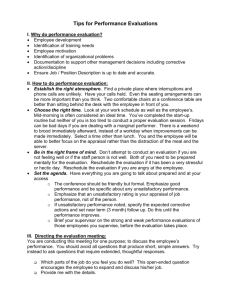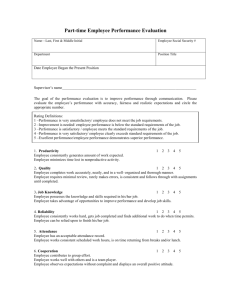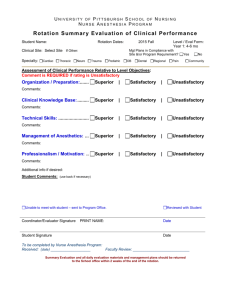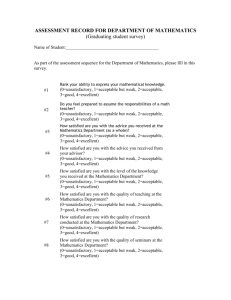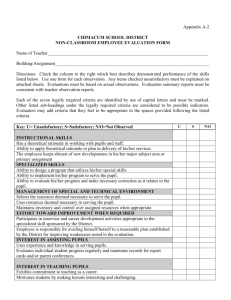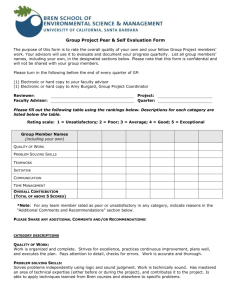Managing people managing performance
advertisement
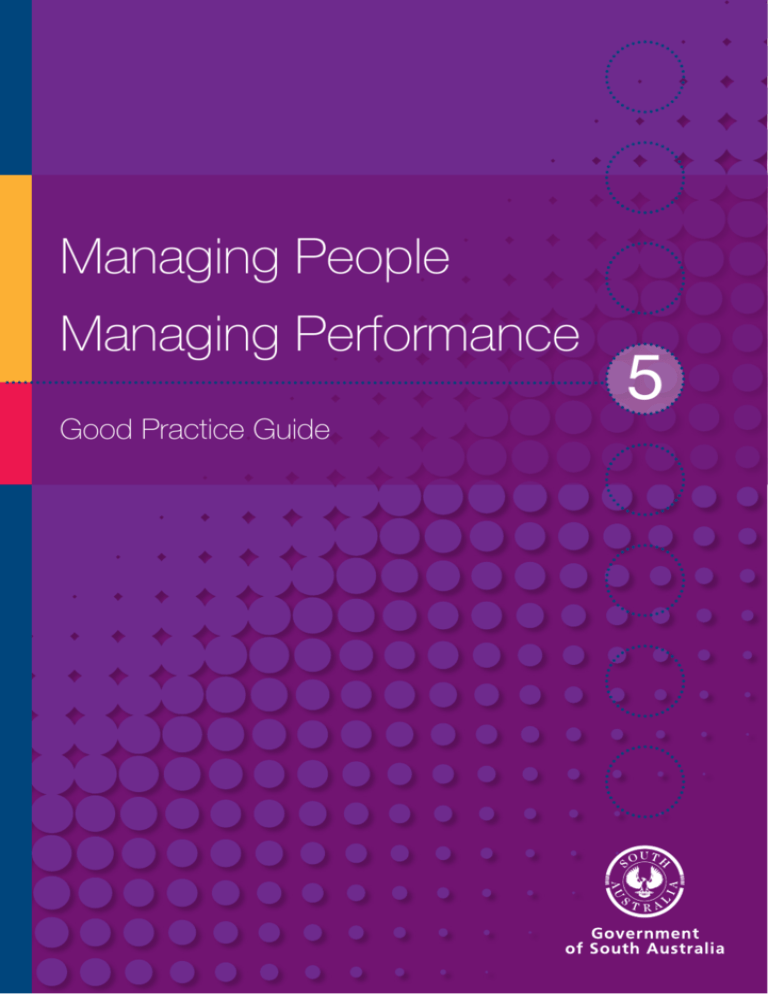
Managing People Managing Performance Good Practice Guide 5 Contents How to use this guide 4 Responsibilities for performance 5 What is performance management? 6 Part 1 The manager’s guide 7 When do I manage performance? 8 How do I manage performance? 8 Managing performance improvement 13 Part 2 Solving tougher problems 14 Intentional unsatisfactory performance - Misconduct 14 Unsatisfactory performance - Inability 14 Unsatisfactory performance - Ill health 14 Principles for managing unsatisfactory performance 15 Investigations 16 Part 3 Excuses not to manage performance, and other myths 17 Appendix 1 - References 20 Appendix 2 - Notes on conduct 21 Appendix 3 - Resources for expanding your performance management skills 22 This is one of a series of guides developed by the Government Reform Commission to promote and support good practice in the South Australian public sector. © Government of South Australia This document may be reproduced in whole or part for the purpose of study or training, subject to the inclusion of an acknowledgement of the source and to it not being used for commercial purposes or sale. Reproduction for purposes other than those given above requires the prior written permission of the Government of South Australia. This Guide does not substitute for agency-level policies nor specialist human resource management or legal advice. 3 Foreword The Hon. Jay Weatherill MP Minister Assisting the Premier in Cabinet Business and Public Sector Management South Australia’s Strategic Plan sets ambitious targets for our state’s future. To achieve these targets we will need to invest in our government’s most important asset – its people. The Government wants a results driven public sector where staff know what is expected of them and how they will be supported. The expectations of the State Strategic Plan flow through Chief Executive contracts to public sector agency business plans and into individual work plans. The best outcomes require a clear line of sight linking everyone’s work to the expected results for their agency. For too long performance management has been seen as a negative or punitive process. Performance management must be seen as a positive process designed to let our people grow and learn. This means good performance is recognised and there are ways of identifying where and how performance can be improved. This guide recognises that managers need assistance to manage performance and provides useful advice on how to do this well. The guide emphasises open and transparent processes and respectful communication between managers and employees. It values flexibility in managing performance; recognising that each agency needs to pursue its diverse obligations in different ways. I recommend this Guide to all public sector managers. 4 How to use this Guide Managing performance is not always easy, as there is no ‘one size fits all’ approach to managing people and their performance. The renowned academic and author on business and management, Henry Mintzberg is credited with saying “management is, above all, a practice where art, science, and craft meet”. This Guide is not a rulebook. While managing performance often includes some set processes, it is more frequently a fluid, non-linear activity. Successful performance management is not about ticking boxes once a year; instead, it requires an understanding of relevant principles and applying them appropriately in any given situation. This Guide is intended to be a practical resource to help managers with the full range of performance management activities - providing feedback, planning development, recognising performance and improving performance - for both day-to-day management and for performance reviews. All levels of performance are addressed in this Guide, including how to effectively manage unsatisfactory performance. However, it is not a substitute for agency policies or specialist advice, and managers are encouraged to seek assistance from Human Resources Management specialists and/or the Crown Solicitor’s Office where necessary. Responsibilities for performance Everyone in our workplace has an important part to play in organisational performance. Good organisational performance is the result of highquality functioning by the individuals within it. Chief Executives are responsible for managing their workforce. They should be committed to their agency’s performance management policy, procedures and systems, and clearly demonstrate this commitment. Line Managers are responsible for guiding and managing the performance of employees, both as individuals and as a team. Managers need to set performance objectives, provide feedback, appraise performance, guide development and ensure employees are rewarded for good performance. Employees are responsible for their performance and their participation in performance management, both formal and informal. 5 Tip When developing policies on performance management, succinct, principles-based documents are best. The more layered and bureaucratic a policy is, the more difficult it will be to follow and apply and may create unnecessary difficulties for managers. Rather than attempting to define every possible scenario, effective policies are principle based tools, to be followed so far as is reasonably possible in given circumstances, and can be supplemented by specialist advice as required. 6 What is performance management? Performance management is simply a term used to describe a set of activities that assess whether goals or objectives are being met. These activities include defining work, setting goals, providing feedback and encouraging development. Performance management is about shared responsibility and understanding of roles, expectations and standards. Every day, we all ask ourselves: What do I need to do? When shall I work on it? How do I achieve the required quality? These questions can apply to the day’s work, or to the planning of the work for the next week, month or year. A manager’s job is to decide whether an employee’s achievements match what was expected. It is also the manager’s task to connect the employee’s work to organisational objectives (that is, provide role clarity). Your organisation may have formal performance management systems that require an annual appraisal or review. While these formal elements of performance management are important, the more critical aspects of managing an individual’s performance are daily interactions and feedback. Performance that is not actively managed is nonetheless influenced by default. Failure to provide feedback means employees are unaware of whether their performance is acceptable and valued and can be a major disincentive to stay with the organisation. Furthermore, failure to manage negative performance can have harmful consequences on the morale of the rest of the work team. Performance reviews A performance review is usually a structured meeting where an employee’s performance over a given time period is assessed and future developmental needs are planned. The review should build on the informal performance management process that has been undertaken daily. The main purpose is for both the manager and the employee to gain an overview, in the form of a retrospective summary of performance and a prospective look towards the employee’s ongoing performance and development. The performance review is usually part of an organisational performance management system. It provides for consistency of practice across an organisation. Both feedback on, and development of performance are essential ingredients of managing performance. By fulfilling their duty to improve performance as part of their everyday work, managers increase the quality of employee work outputs and engagement. Part 1: The manager’s guide As a manager, you are critical to the success of the organisation. Not only do you assist staff in understanding their role within the organisation, assist them in their development, and monitor their work to ensure it is satisfactory, but you also create organisation culture. The saying that ‘people join organisations but leave managers’ has been verified by a number of recent studies. It is performance management-related activities that influence how much effort employees put into their work, as well as their attitudes and commitment to an organisation. Good managers produce high-quality, effective workers who are engaged with their work and want to remain in the organisation. Managing performance is a key part of the ongoing communication process between you and your staff. It has to happen every day in order to: > clarify expectations > set goals > provide guidance and feedback > develop skills and knowledge > advance career development. More broadly, managers must also take responsibility for the following elements. 7 Ensuring employees understand their ‘fit’ within the organisation Create an understanding of how an employee’s work helps the organisation to achieve its goals, and help them feel that you and the organisation value them. Encouraging a culture of performance Promote open ‘two-way’ communication with employees; be flexible and support employees when something doesn’t go to plan for no fault of their own; and encourage innovation. Helping to build networks amongst talented employees Allow employees to work together and share areas of expertise, creating job-focused networks that help meet work objectives. New skills and ideas and higher ambitions and goals increase employee engagement. Demonstrating commitment to employee development Helping employees to achieve their future career goals is important. Talk about career plans and help develop knowledge and skills in their current position that might be useful for future job opportunities. Tip Ensuring person-job ‘fit’ Carefully match people to positions. Employees who are good at their work and enjoy it are better performers. Maintaining a positive relationship between the employee and the organisation Manage perceptions of the organisation and senior employees by explaining organisational vision and strategy and the actions of decision makers; encourage innovation; ensure employees understand the benefits of working in the organisation; and emphasise its positive features. Performance management activities influence how much effort employees put into their work, and also their attitudes and commitment to the organisation. Good managers are associated with high-quality, effective employees who are engaged with their work and want to remain in the organisation. 8 Part 1: The manager’s guide When do I manage performance? The short answer is: every day! Performance management is a process not an event. While it may appear simplistic, the day-to-day communication process about what needs to be done and feedback on how well it is being done is often overlooked. Many managers are not aware that they are not providing sufficient feedback and guidance. In addition to informal everyday interactions, managers will participate in their agency’s formal performance reviews. These are usually held at regular intervals during the year. The key to effective formal performance reviews is a ‘no surprises’ approach, which is why day-to-day feedback is so critical. Whether formal or informal, performance management is based on three important principles: Tip The Corporate Leadership Council (2005) (CLC) analysed data from over 90,000 employees in 135 organisations around the world. The research showed that managerial behaviours have a disproportionate impact on employee performance and retention and hence on the organisation’s success. CLC found that there are key people management strategies, which managers can use that are most effective for encouraging high performance and retaining good workers. Those that relate to the first role of a manager (that is, enabling daily performance) include three basic and critical steps. In fact, if a manager did nothing else to manage their employees, this alone would have enormous impact on organisational productivity and employee performance and retention. 1. Set clear performance expectations. 2. Provide fair and accurate informal feedback. 3. Help to solve everyday problems. When being done effectively, formal and informal processes are mutually supportive. How do I manage performance? When a manager provides employees with clear expectations, feedback and problem solving, not only is employee performance enhanced, but there is also a positive influence on the employee’s attitude to, and relationship with the organisation. 1. Set clear performance expectations Guiding the way people go about their work is based on the belief that doing things correctly will lead to quality outputs. Clearly defining the actions and behaviours needed to perform the duties of a role is often as important as defining the required output. > Performance expectations should be SPECIFIC and ACHIEVABLE, and should focus on the OBSERVABLE. Specific means being precise. For example, it is more useful to say, “I would like you to greet customers with a smile and friendly ‘hello’” than to say “I want you to provide good customer service”. By being specific about observable behaviour, managers will find it easier to effectively communicate with employees about standards and expectations. For example, “Kerry I noticed you came in 30 minutes after our team meeting started; was there a reason?” 9 is more effective and beneficial than “Kerry you were late again, you should be on time”. Achievable means that the employee can objectively achieve the expected outcomes within the limitations of their abilities and available resources and timeframes. Observable means it is a behaviour that can be measured. For example, to say that someone was aggressive is vague in meaning and assumes you know what was intended by the behaviour. If you say, “when you shouted...” the employee knows exactly what you are discussing; similarly, when you refrain from inferring intent you avoid getting it wrong, for example, the person may reply “I was not aggressive; I raised my voice because the customer was hearing impaired”. Tip SafeWork SA uses the following paragraph in covering letters to prospective employees to ensure they are aware of the agency’s expectations during the probationary period and that confirmation of continued employment is dependent on satisfactory performance: “I am now pleased to offer you this position. If you accept this offer, you will be appointed on an ongoing basis with a probationary period. During the probationary period you will be required to undertake regular performance management meetings to ensure that satisfactory performance against the position description is being achieved. Should satisfactory performance continue to be achieved, at the completion of the probationary period you will be confirmed ongoing. Continued unsatisfactory performance will result in your appointment not being confirmed.” 2. Provide fair and accurate feedback Objective and fair feedback about performance can be one of the most powerful drivers of employee performance. Fair and accurate feedback is most effective when it occurs soon after the event or work is done, and therefore feedback should be given informally on a daily basis. In order to be fair and accurate, feedback should also come from someone who knows about the employee’s work and their performance. Feedback is most useful when it is specific and relates to observable behaviour. This may include practical advice or guidance about how performance may be improved, or an acknowledgement of what the employee is doing well. Focus on strengths Focusing on an employee’s strengths is one of the most influential things a manager can do to enhance performance (CLC, 2005). It is easy to assume that people know when they are doing something correctly or well, but often this is not the case. Positive feedback motivates and encourages even higher levels of effort and performance and reinforces a culture of continuous improvement. Like all feedback, positive feedback should be timely and: > relevant to the individual’s style and preferences > specific, giving examples of work and behaviour and its impact > equal to the employee’s effort and achieved outcomes. Comments such as “you handle customers well” are not specific enough. It is far better to be precise. For example, “when you picked up the phone within three rings and answered the customer’s question with simple, clear information, you met their needs and left them with a sense of good service”. 10 Part 1: The manager’s guide Providing constructive feedback Constructive feedback focuses attention on aspects of an employee’s performance that require improvement. However, the fact that an employee’s performance needs improvement does not mean that feedback need be negative or critical. Use the same approach and criteria as for positive feedback, and: > provide the feedback sensitively > ask employees for their viewpoint, allowing time for discussion > clarify the situation and work towards agreement about it > agree on specific behaviour change or work outcomes as the new goal > give employees an opportunity to openly discuss their perception of their performance. Where practical, it is also useful to combine constructive feedback with a discussion of an employee’s strengths. Constructive feedback improves performance if it is relayed positively and includes specific advice on performing the task better. Not providing feedback for improving performance may seem kind, but it denies the employee the opportunity to improve. Tip Are you familiar with people who, over their whole career, remain oblivious of characteristics of their work style that hold them back - and everyone except them knows what needs to be remedied? This is often the result of a lack of constructive feedback. Don’t deny your employees the opportunity to improve and progress in their careers by withholding information they need to be able to do so. It is important to identify the reasons for a decline in an employee’s performance. A variety of issues of which you are not aware may lead to diminished employee performance. Work in partnership with the employee to develop clear strategies that they can adopt to improve their performance. Make sure they leave with a clear understanding of what they need to do to improve their performance and how you will work with them to help them do so. If day-to-day communication includes effective feedback, then the manager need not be apprehensive about giving negative feedback at the annual performance review, and the employee need not fear any unpleasant surprises. In effective organisations, formal meetings confirm knowledge already shared during informal discussions. Feedback can then be used to further develop capability and to form plans for role and career development. 11 Assessing performance Effective performance evaluation is a useful tool for employees to get a clear understanding of their manager’s views about their work. Performance appraisal/assessment analyses work for its timeliness and quality and uses this information to make adjustments to future work, in order to remain ‘on track’. The key task for managers in assessing performance is to provide the employee with clear information about how effectively they are performing their duties and role. Tip The difference between ordinary feedback and formal appraisal is that assessment or appraisal is usually made against some benchmark level. “You answer the phone promptly” is feedback. “Your phone answering was competent because you met the benchmark of answering the phone within six rings 90% of the time” is assessment. Having a structure in place to guide performancerelated conversations with employees can assist managers to get to know employees better and is likely to improve the trust and respect employees have as a result of feeling more valued and appreciated. Typical topics addressed in performance-related conversations include: > Technical and professional abilities - the employee’s level of expertise in performing the duties of the role; for example, administration, finance or policy advice. > Leadership and management - how people lead and manage the performance of others. > Communication - all forms of communication rely upon how well information, ideas and proposals are expressed. > Task and work output - in terms of timeliness and quality. > Relationships - how effectively a person works with others in the unit and/or organisation, as well as with external contacts. > Management and development of self - a person’s ability for self-reflection and learning, stress management and attaining work-life balance. Employees should also be encouraged to regularly evaluate their own performance. Self-assessment gives managers an informed starting point for discussion and allows them to be aware of an employee’s perception of their own performance. Another way to make appraisal more valid - and hence more acceptable to the manager and the employee - is to use multiple sources of feedback. The more sources of feedback, the more robust the evidence about performance. For example, 360-degree feedback consists of data gathered from a manager, peers and employees and can also include customers and other stakeholders. It is preferable for performance assessment to be a two-way conversation in which employees rate their managers, particularly with respect to their perception of the level of managerial support they have received. This approach can foster a cooperative, action-based and solution-focused discussion. When managers seek feedback on how to be better managers they can improve their performance as well as that of their employees. 12 Part 1: The manager’s guide Identifying development needs A performance assessment process should identify an employee’s work capabilities, including areas that require development. Managers should consider the following: > What strengths does the person already have that they can build on to achieve the goals in their individual performance plan? > What skills and capabilities are needed to successfully achieve work goals? > Which capabilities will have the greatest impact on performance? > What additional capabilities may they need to take the next step in their career? > Are there any career-limiting factors that should be addressed? The next decision is to decide on the priorities and timeframes for development. Developing high performance Development is most effective when it meets an individual’s needs and career aspirations as well the employer’s requirements. Planning for development considers: > the tasks of an employee’s role > the potential for an employee to work in different roles within the organisation or wider public sector > the capacity to work in new roles or careers. Developmental planning simultaneously communicates to employees that management is committed to their success, while promoting engagement to the work and commitment to the organisation. Skills development, like feedback, is an ongoing process. It can include on-the-job training, mentoring and formal education. Usually development is reviewed at the formal performance review. Ideally, this involves forward-looking discussions between managers and employees about developing skills and knowledge in order to allow the employee to perform better in the current role and to facilitate future career development in the desired direction. Rewards and recognition Financial rewards are largely not appropriate in the public sector, but rewards such as development and career opportunities are highly valued. Non-tangible rewards, such as recognition, can have an immense impact on employee performance and retention. The most powerful recognition is informal spoken feedback about performance. If this is incorporated into career planning, it becomes associated with rewards. In addition to acknowledging and encouraging good performance wherever possible, managers should also recognise and support effort and improvement. 3. Help to solve everyday problems Research undertaken by the CLC has found that ‘employees whose managers provide solutions to work problems put nearly 22 percent more effort into their job, are nearly 43 percent more committed to the organisation and feel 39 percent more closely matched with their jobs than do employees who have no manager assistance in solving day-to-day problems at work. Enabling solutions is therefore a key management task. As a manager, you can help your employees by removing barriers; assisting them to get the information, resources or technology they need; breaking down projects; translating long-term goals; clearly communicating expectations and acting as a catalyst to get new initiatives going. 13 Managing performance improvement Support is available from: Performance varies according to context and over time. Improving performance is a part of performance management and should not be feared by managers or employees. When constructive feedback is not enough to lift performance, more formal management may be needed. > agency human resources staff Finding the reason for unsatisfactory performance In dealing with unsatisfactory performance, it is vital to first identify its cause. Managers should seek answers to questions such as: > What is the specific nature of the unsatisfactory performance - is it related to the performance of the technical duties of a role or is it behavioural? > Has the employee worked at the required standard in the past or not yet reached that level? >Is there a mismatch between the capabilities of the employee and the requirements of the position? > Is the performance situation temporary; for example, is it due to some transient reason, work overload, health or personal reasons? What next? Both the employee and the manager need to: > be clear about the expected level of performance or behaviour and identify what would meet the performance expectations > establish achievable goals and timeframes > ensure there are sufficient coaching supports, resources and feedback. > the Employee Assistance provider > private counsellors > external experts who can be used to support the line manager or even to undertake parts of the process, such as coaching or problem resolution > mediators > the Crown Solicitor’s Office > agency industrial relations or legal staff. In complex situations it may be better to engage in a case management approach, where multiple parties meet to work together and share perspectives. Typically, a case management approach involves a team including managers, human resource practitioners and other specialist professionals; for example, workers’ compensation specialists and the Crown Solicitor’s Office. 14 Part 2: Solving tougher problems As the employer’s representative, it is the manager’s responsibility to address unsatisfactory performance, whatever its nature or cause. to perform the duties of the role. If informal efforts to address unsatisfactory performance have been unsuccessful, managers have an obligation to initiate formal processes. must be addressed. Examples of temporary causes There is no simple way to manage unsatisfactory performance and the fact that a situation is complex, time consuming and labour intensive is not justification for managers avoiding their responsibility. causes have been addressed, an employee’s Unsatisfactory performance can be categorised into a number of types, but it is important to remember that any aspect of an employee’s behaviour or performance can constitute unsatisfactory performance. employed to manage the issue. In the context of employment, the terms ‘conduct’, ‘behaviour’ and ‘performance’ refer to one and the same thing. Managers should not artificially separate employees’ performance of technical duties from their overall conduct. this is caused by mental or physical illness, then Intentional unsatisfactory performance Misconduct > confirm the reason for the unsatisfactory Misconduct occurs when employees’ behaviour is unsatisfactory, breaches their contract of employment, or fails to meet the requirements of their duties. In the public sector, a breach of the employee conduct standards and/or Code of Conduct for Public Sector Employees will amount to misconduct. > provide a timeframe for any expected improvement If an employee is able to perform duties to the required standard but chooses not to, then this unsatisfactory performance may amount to misconduct. Absence from work without authority or failing to attend in line with working hours are examples of common forms of unsatisfactory performance that equate to misconduct. When managing unsatisfactory performance that may Unsatisfactory performance - Inability Where unsatisfactory performance is not deliberate, it may arise due to inability on the part of an employee Regardless of whether an employee’s inability to perform is temporary or permanent in nature, it of unsatisfactory performance include personal problems and/or ill health. Usually, once transitory performance will improve. But if this does not occur, or if the causes of unsatisfactory performance are ongoing in nature, formal processes will need to be Unsatisfactory performance - Ill health If an employee is not performing duties satisfactorily (including breaches of discipline) and it appears that medical information will be valuable in determining what action to take in order to assist the employee and to improve performance. While this information may not alter the outcome, it may: performance of performance > help predict the degree of impact of the incapacity > allow an informed decision to move to unsatisfactory performance management options. be caused by mental or physical illness, it is important to refer to the relevant employment legislation and/ or any industrial instruments, such as Awards or Commissioners Standards. Public servants, for example, may be directed to undergo a medical examination and may be suspended from duty - with or without pay - if they do not comply with such direction. 15 Principles for managing unsatisfactory performance Timeliness employees may successfully argue that they were denied procedural fairness, which in turn could affect substantive decisions. Regardless of the nature or possible cause of unsatisfactory performance, it is vital that it is addressed as soon as possible. When making administrative decisions, decision makers should also: Natural justice, procedural fairness and other principles of administrative decision making > disregard irrelevant considerations The rules of natural justice and procedural fairness and other principles governing administrative decision making must be followed. This is always the case, regardless of the nature or cause of the unsatisfactory performance. > ensure that the decision is reasonable (that is, it is one a reasonable decision maker would have reached). The rules of natural justice apply whenever the rights or legitimate expectations of an individual are influenced by a decision. There are three basic principles employers must follow; these are commonly known as the hearing rule, the bias rule and the no-evidence rule. The hearing rule requires that a decision maker must give a person whose interests may be adversely affected by their decision an opportunity to be heard. > take into account relevant considerations > act for a proper reason The decision maker has a two-fold duty to take account of relevant considerations and to ignore irrelevant ones. Relevant employment matters will usually be pertinent, and include factors such as: > the nature and seriousness of the alleged behaviour under examination > the procedure adopted by the employer in investigating allegations > the evidence gathered in an investigation > the employee’s responses to the allegations. The bias rule requires that the decision maker be disinterested and unbiased with regard to the matter to be decided. Not only should justice be done, but it should also be seen to have been done. Factors such as the employee’s marital status and political beliefs would not only be irrelevant considerations, but would inevitably amount to unlawful discrimination. The no-evidence rule means that the decision that is eventually made must be based on logically relevant, sound evidence. The industrial principle of condonation The term procedural fairness is often used interchangeably with natural justice, but it is a distinct concept. Essentially, procedural fairness requires that the process leading to a decision is fair. This is particularly important where there are defined policies and processes for administrative decisions, such as Commissioner for Public Employment Standards. Where agencies have specific policies or procedures, it is important that these be followed as closely as is reasonably possible to prevent situations in which A common problem with managing unsatisfactory performance is that it is often not addressed in a timely fashion, therefore the behaviour is seemingly condoned by management. Only after an accumulation of unsatisfactory behaviours over a lengthy period does a manager become frustrated and decide to take action. This manager may believe that the accumulation of such behaviours can be used as evidence of unsatisfactory performance or misconduct, even though the situation has in fact not been managed effectively. Constantly ignoring unsatisfactory performance or inappropriate 16 Part 2: Solving tougher problems Once a behaviour is considered to be condoned, management is not entitled to formally deal with it retrospectively. The previous unsatisfactory performance may be relevant only from the perspective of an employee’s character. If behaviour is condoned, management is not able to use the cumulative behaviour as a basis to impose a more serious penalty as it would normally be able to do if the behaviour had been appropriately managed. It is important that interview records or notes of observations are made either at the time of the event or as soon as possible. Where notes relate to conversations they should, as far as reasonably possible, be noted in dialogue form, recording the actual words used. This means the person making the notes has not added any interpretation, comment or opinion. Where statements are taken in the course of an interview, care should be taken that witnesses’ observations are accurately recorded in their own words. Investigations Acting on the available evidence Where an investigation into suspected unsatisfactory performance or misconduct is required, and management believes it lacks the expertise or resources to conduct the investigation itself, the Crown Solicitor’s Office may be requested to use the services of the Government Investigations Unit. A major advantage in utilising the Government Investigations Unit to conduct investigations is that investigators are acting on instructions of the Crown Solicitor and gathering evidence for the purposes of providing legal advice; therefore, evidence gathered will be subject to legal professional privilege. This means the evidence will usually not be obtainable by employees or outside parties by means of freedom of information applications. If evidence gathered confirms (or strengthens) suspicions that an employee is performing their duties unsatisfactorily, a formal meeting is usually arranged. Management may require employees to attend an interview at a specific place at a certain date and time. Employees must be permitted to be accompanied by a representative during interviews. management responses, such as repeated informal warnings effectively condones the behaviour. Employees need not be advised that their suspected conduct is the subject of an investigation until such time as the process is at the stage where the employees’ rights, interests or legitimate expectations could be adversely affected by a decision. In many instances, it will be preferable that an employee not be aware they are being investigated. Every effort should be made to collect material that is relevant to and supportive of allegations. Management may seize or order the return of government equipment/assets should this be deemed necessary and relevant to an investigation. Ideally, persons participating in an investigation should not act as decision makers, nor should they discuss with or provide to the decision maker any information connected with or relevant to the allegations. A person is not obliged to answer a question if it might incriminate them of a criminal offence. However, depending on the circumstances, an adverse inference may be taken from an employee’s silence. Sanctions and review The sanctions available for proven incidents of unsatisfactory performance or misconduct will be determined by the relevant employment legislation or, if not part of such legislation, will be governed by Common Law. Likewise, employment legislation will often provide for rights of appeal/review; if not, the provisions of the general industrial legislation - the Fair Work Act 1994 - will apply. Crown Solicitor’s Office Agencies may seek assistance from the Crown Solicitor’s Office in managing unsatisfactory performance, and are encouraged to do so in complex matters or circumstances where termination of employment is being considered or is a possible outcome of a process. Part 3: Excuses not to manage performance, and other myths 17 Excuse Reality My staff don’t want to be performance managed. Most people want and expect feedback. Even corrective feedback is valuable because it gives people a chance to improve their performance and be more successful. Sometimes, giving corrective feedback can be difficult; however, this is an essential part of managerial responsibilities. It’s risky to talk to employees about something that needs improvement, as they may take offence. You can provide honest, critical feedback in a way that is likely to be perceived as constructive. Failing to address an issue in a timely manner is more risky, as it can cause significant problems in the future, especially if formal processes become necessary. I am busy managing the work and don’t have time to waste on performance management. Managing performance is part of getting work done. Investing time in building relationships with your staff and helping them to develop is not time wasted - on the contrary, it will improve their performance and hence their work output. It’s easier to ignore underperformers and move them on to someone else to manage. It’s easier at the time, but not in the long term. Ignored underperformance rarely goes away and it gets increasingly harder to tackle. If you knowingly pass off an underperforming employee you are abrogating your managerial duty and may be liable for disciplinary action. I don’t have a right to address employees’ behaviour at work unless it’s about their actual work tasks. They have a right to behave how they like. In the workplace, conduct and behaviour are conceptually one and the same. All conduct by an employee is relevant to the assessment of whether or not they are performing their role satisfactorily. The Code of Conduct makes it clear that the behaviour of public sector employees may be subject to scrutiny and considered as unsatisfactory performance, even if it occurred outside working hours. I can get away with an annual performance development session and never having to actually tell employees what they do well or need to improve on. Performance management is an ongoing process, not an event. Managers are responsible for helping to develop their staff, which includes providing feedback on areas that need improvement. It is all up to me as the manager, and I can’t ask colleagues to assist. You may seek additional information and assistance. Your human resources department is a valuable source of information and assistance. 18 Part 3: Excuses not to manage performance, and other myths It’s not worth the effort and does not pay off. It is wrong to assess the effort and resources required to properly manage employees against your perception of the value of doing so. The effective management of performance is a primary managerial responsibility and has significant impact on employee performance and retention. Performance management is about managing bad performance. Performance management is not only about improving unsatisfactory performance; it is also about rewarding and encouraging good performance and assisting employees to excel. It’s okay to bring out feedback you’ve been storing up for months. This type of managerial behaviour could give rise to a successful workers’ compensation claim, as it is unreasonable. Behaviour that has been ignored or not addressed may be legally considered as having been ‘condoned’, and this means you may not be able to use it for an unsatisfactory performance/ disciplinary process later on. Only employees’ performance needs to be reviewed, not that of managers. All employees, regardless of their level, are obliged to participate in performance management. I cannot manage the unsatisfactory performance of employees if they have lodged a claim for workers’ compensation. This is untrue. Performance management and workers’ compensation are separate systems. It would be sensible to advise injury management staff of your intended actions. As with any other employee, it is important that these employees are afforded natural justice and procedural fairness whilst their alleged unsatisfactory performance is being addressed. If I suspect the conduct of an employee is unsatisfactory, I am obliged to advise them I intend to conduct an investigation as a result of my suspicions. There is no obligation to advise employees their conduct is the subject of investigation, until such time as the investigation is at a point where decisions adverse to the employee may be made. In practice, this means that when enough evidence is gathered, allegations can be put to the employee to afford them an opportunity to respond. I cannot access files in a workplace computer that employees have labelled ‘private’. Employees have no ownership right to property of the employer. If required, employers can access any directory in a workplace computer at any time, or open, forcibly if necessary, any workplace furniture. I cannot open drawers or lockers in the workplace that employees have locked or consider private. 19 I cannot manage unsatisfactory performance unless I have a comprehensive performance management plan in place, or until a considerable time after consideration of the employee’s progress under their plan. Performance management does not always require a formal plan. What is required is that employees are advised of how their performance is unsatisfactory and are provided with a reasonable opportunity to address such unsatisfactory performance. Where formal performance management plans are deemed appropriate, it is not necessary that employees agree to their content. As a manager, what I say goes. Therefore I don’t have to give employees feedback about their unsatisfactory performance if I don’t want to. Employees are entitled to expect, and you are obliged to inform them, in detail, as to how their performance is allegedly unsatisfactory. You cannot formally address alleged unsatisfactory performance without providing information to the employee. Such management is open to allegations of bullying and harassment and may leave you liable to disciplinary action. If I believe that employees’ unsatisfactory performance is caused by mental or physical illness or disability, You are entitled to require a public servant to submit to a medical examination in these circumstances. Medical qualifications are not necessary to form an opinion that is based on your general knowledge, education and life experience. > I cannot require that they attend a medical examination You are entitled to direct public servants to submit to a medical examination. > I don’t have the right to ensure they stay away from work while unfit to perform their duties. With the exception of Return to Work Plans under the Workers Rehabilitation and Compensation Act 1986, employers are entitled to demand that employees attend work in a healthy state, fit to perform the full range of their duties without restriction. When managers believe public sector employees are unable to perform their duties due to reasons of health, they may direct them to leave a workplace and not to return until medically declared as fully fit. This is consistent with the obligation of managers to ensure safe workplaces and systems of work under the Occupational Health, Safety and Welfare Act 1986. The policy on managing unsatisfactory performance will be more effective if it is as comprehensive as possible. The most effective policies are principle-based tools, to be followed so far as is reasonably possible in given circumstances. Complicated and bureaucratic processes usually lead either to more procedural errors, are less likely to be read and/or properly understood and often act as a disincentive for managers to respond to unsatisfactory performance. 20 Appendix 1 - References Corporate Leadership Council 2005, Corporate Executive Board Washington, D.C. United States Hart, PM & Cooper, CL 2001, ‘Occupational Stress and Well-Being’ in N Anderson, DS Ones, HK Sinangil, & C Viswesvaran (eds), Handbook of Work and Organizational Psychology, Sage, Newbury Park, CA. Performance Management in the Australian Public Service 2001, Australian Public Service Commission Management Advisory Committee, Canberra. <http://www.apsc.gov.au/publications01/ performancemanagement.pdf> Performance Management Supermarket <http://www.cpe.sa.gov.au/default.asp?idL1=854&id L2=876&idL3=1066> The Online Competency-Based Role Description Builder <http://www3.skillassess.com/saus/login/ login.cfm> Note that you will need to contact your Agency HR Administrator for a password to access this site. SAES South Australian Executive Service at <http:// www.saes.sa.gov.au> Performance Management Tools Fact Sheets: The following fact sheets are additional resources you may use and are linked to the electronic version of this Guide. Fact Sheet No 1: Leadership and Team Climate Survey Fact Sheet No 2: Management Skills Assessment Fact Sheet No 3: Management Essentials Framework Fact Sheet No 4: Performance Management Toolkit Fact Sheet No 5: Competency-Based Role Description Builder Fact Sheet No 6: Online Performance Management Fact Sheet No 7: Competency Framework Fact Sheet No 8: Performance Standards Fact Sheet No 9: Upward Feedback Process Fact Sheet No 10: Organisational Health Surveys Appendix 2 - Notes on conduct 21 Employee conduct Employer conduct Public employees are expected to uphold high standards and principles of practice. Their role is to provide services to the community in a professional, responsive manner, characterised by integrity and respect. Public sector employers are expected to: The Code of Conduct for South Australian Public Sector Employees provides an outline of the behaviour expected of public sector employees. In practice this means: > endeavouring to give your best to meet performance outcomes and other organisational requirements > treating others with respect, courtesy and regard for their dignity > continuously improving your performance in delivering your services. Chief executives use the Code of Conduct to guide ethical behaviour and professional integrity, and all public sector employees must observe it. Breaches of the Code amount to misconduct and may lead to disciplinary action, including termination of employment. > set clear objectives for employees > acknowledge employees’ successes and achievements and address underperformance > treat employees fairly, justly and reasonably > prevent unlawful discrimination against employees or prospective employees on the grounds of sex, sexuality, marital status, pregnancy, race, physical impairment, or any other grounds. 22 Appendix 3 - Resources for expanding your performance management skills Organisational climate Your organisational performance management framework may provide the means to assess the climate of your organisation and to evaluate the morale of the workforce. However, as a manager, you can supplement what your organisation provides and enhance performance management by gathering feedback about the morale and wellbeing of your own employees, or about perceptions of your performance as a supportive manager. Fact Sheet No. 10: Organisational Health Surveys, which is linked to the electronic version of this Guide, offers assistance in doing this. (Please refer to the references above for a full list of fact sheets.) Other sources of organisational information can help you monitor employee wellbeing and morale. For example, you can monitor sick leave to identify potential morale issues or signs of work overload and poor work-life balance. 1 Training and supporting the performance review and development conversation High-quality interaction between managers and employees builds trust. To be comfortable enough to participate in performance management discussions, managers and employees need confidence that is based on skills and knowledge. Accordingly, training and providing relevant documentation make it easier for people to have conversations about work, to recognise and reward good performance, and, where necessary, work towards improving unsatisfactory performance. Some agencies provide specific resources for managers, for example, the Performance Management Supermarket1, which is an example of a government-wide online resource. In addition to these resources, agencies should facilitate performance management training for managers. Performance Management Supermarket at <http://www.pmsupermarket.ocpe.sa.gov.au/> 23 Evaluate your way to success Another useful tool is a short survey on a regular Even the best performance management systems can only work as well as the people utilising them. Surveys are one way of evaluating the effectiveness of the performance management system. This may require some data gathering at the end of the annual cycle, and can be achieved relatively easily by using one of the web-based survey tools, such as Zoomerang or Survey Monkey2. It may also be informative to run a focus group or speak to a few individuals. The collective perceptions of employees can be very helpful in answering important questions like: basis. These need only take a few minutes to > Was the process a successful experience and implemented appropriately? > What worked particularly well? > What areas require further attention, resources or support? Credibility is greatly improved when results and information are communicated to employees, with an indication of which improvements/changes are planned for the future. If there is a representative employee group involved in implementation, they could be used to review this information and could provide suggestions for further fine-tuning the process. 2 <www.zoomerang.com>; <www.surveymonkey.com> complete, but can nonetheless provide a good social barometer and indication of organisational and management effectiveness. Short surveys may involve asking a handful of questions about leadership or team climate, for example. Refer to Fact Sheet No. 1 for an example of an automated system developed by Homestart Finance. A regular evaluation process should be part of the overall management system of an organisation, so that improvement can be guided by information obtained from each evaluation cycle. Honest feedback, both positive and negative, will build trust if it is respectful and objective. If the organisation’s performance system is not effective in a particular workplace or with a particular person, it should be supplemented with something that is effective. Expert advice can be sought if necessary. Managers must remember that every person is different and that the way in which feedback is provided will sometimes have to be tailored to meet an individual’s needs and specific role within an organisation.

